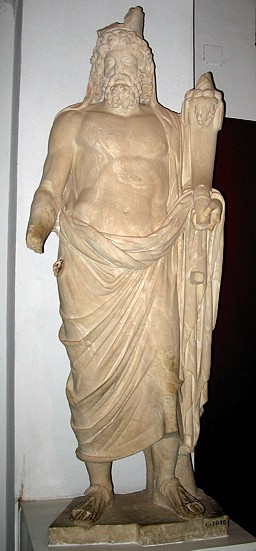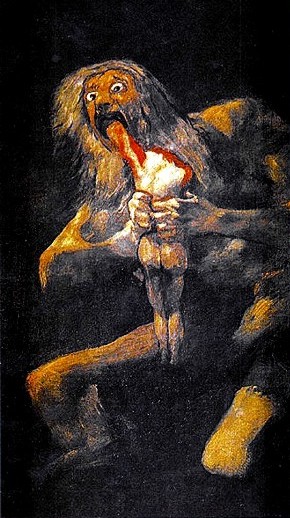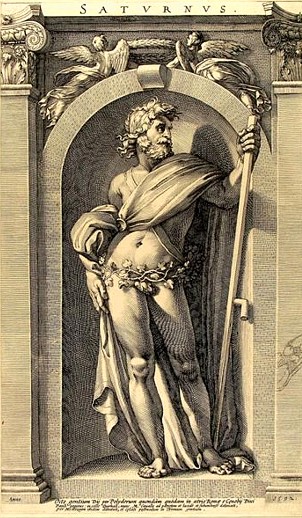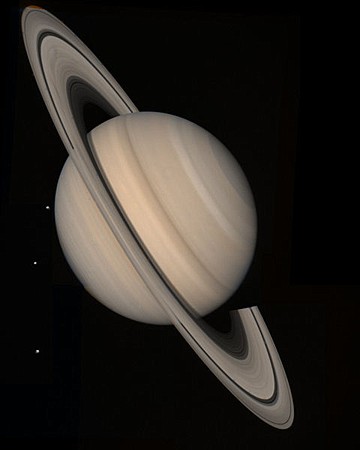Lessico
Saturno

Scultura
romana del II secolo
Museo nazionale del Bardo - Tunisi
Saturno – Saturnus in latino – era la divinità romana
dell'agricoltura. Nell'antichità classica era identificato con la divinità
greca Crono![]() . Secondo i poeti latini, Crono,
identificato appunto con Saturno, sconfitto da suo figlio Zeus
. Secondo i poeti latini, Crono,
identificato appunto con Saturno, sconfitto da suo figlio Zeus![]() , si rifugiò nel Lazio (originariamente
detto Saturnia, terra di Saturno), e quella fu per gli abitanti, che da
lui si chiamarono gente saturnia, l’età dell’oro.
, si rifugiò nel Lazio (originariamente
detto Saturnia, terra di Saturno), e quella fu per gli abitanti, che da
lui si chiamarono gente saturnia, l’età dell’oro.
La moglie di Saturno, Opi![]() , dea del raccolto, divenne l'equivalente di Rea. Saturno era il padre
fra gli altri di Cerere
, dea del raccolto, divenne l'equivalente di Rea. Saturno era il padre
fra gli altri di Cerere![]() , Giove, Nettuno e Ades
, Giove, Nettuno e Ades![]() . Saturno aveva un tempio nel foro romano che conteneva il tesoro reale.
Il pianeta Saturno
. Saturno aveva un tempio nel foro romano che conteneva il tesoro reale.
Il pianeta Saturno![]() fu così chiamato dal nome della divinità già nell'antichità.
fu così chiamato dal nome della divinità già nell'antichità.
Prima delle influenze della cultura greca, Roma possedeva le proprie
divinità, chiamate in latino numina, che significa
"potenze", "presenze" o "desideri". I primi
Romani guardavano ai loro dei in modo meno poetico e più pratico. Questi dei
non erano legati solitamente a una forma particolare o a un genere e non
venivano raccontati miti sui numina. I numina più importanti erano i Lari![]() e i Penati.
e i Penati.
Saturno era in origine uno dei numina e si pensava proteggesse i campi e le sementi. Sua moglie, Opi, proteggeva il raccolto. Più tardi, quando l'influenza greca sulla religione romana crebbe, Saturno venne associato a Crono, il titano padre di Giove.
Nella Teogonia di Esiodo![]() , un racconto della creazione dell'universo e della salita al potere di
Zeus, Saturno viene identificato come figlio di Urano, il Cielo, e di Gea
, un racconto della creazione dell'universo e della salita al potere di
Zeus, Saturno viene identificato come figlio di Urano, il Cielo, e di Gea![]() , la
Terra. Saturno salì al potere, evirando e detronizzando il padre Urano ma
venne profetizzato che un giorno uno dei figli di Saturno lo avrebbe a sua
volta detronizzato. Così, per evitarlo, Saturno divorò tutti i figli appena
nati. La moglie di Saturno, Opi, nascose il suo sesto figlio, Giove,
nell'isola di Creta, e al suo posto offrì a Saturno un grosso masso avvolto
in fasce. In seguito Giove detronizzò Saturno e gli altri Titani
, la
Terra. Saturno salì al potere, evirando e detronizzando il padre Urano ma
venne profetizzato che un giorno uno dei figli di Saturno lo avrebbe a sua
volta detronizzato. Così, per evitarlo, Saturno divorò tutti i figli appena
nati. La moglie di Saturno, Opi, nascose il suo sesto figlio, Giove,
nell'isola di Creta, e al suo posto offrì a Saturno un grosso masso avvolto
in fasce. In seguito Giove detronizzò Saturno e gli altri Titani![]() , diventando il nuovo governatore del Cosmo.
, diventando il nuovo governatore del Cosmo.

Saturno
divora un suo figlio – 1820 circa
Museo del Prado - Madrid
Francisco Goya
Fuendetodos, Saragozza, 1746 - Bordeaux 1828
In memoria dell'antica età dell'oro dell'uomo, un'era mitica durante la quale Saturno aveva governato, venivano celebrati grandi festeggiamenti chiamati Saturnalia che avevano luogo nei mesi invernali, all'incirca al solstizio d'inverno. Originariamente duravano un solo giorno, tenendosi il 17 dicembre, ma in seguito ebbero durata di una settimana. Durante i Saturnalia, il ruolo di padroni e schiavi veniva invertito, i vincoli morali venivano meno e le regole dell'etichetta ignorate. Si pensa che i Saturnalia e i Lupercalia (festa dell'antica Roma che cadeva il 15 febbraio durante la quale operavano certi sacerdoti detti Luperci), siano le origini del Carnevale.

Polidoro
Caldara da Caravaggio
Caravaggio ca. 1500 - Messina 1546
Saturn (Latin: Saturnus) was a major Roman god of agriculture and harvest. He was identified in classical antiquity with the Greek deity Cronus, and the mythologies of the two gods are commonly mixed. Saturn's wife was Ops, Rhea's equivalent – not Magna Mater. Saturn was the father of Ceres, Jupiter, and Veritas, among others. Saturn had a temple on the Forum Romanum which contained the Royal Treasury. Saturn is the namesake of Saturday (dies Saturni), the only day of the week to retain its Roman name in English.
Later concept
Saturn is often identified with the Greek deity Cronus. In Hesiod's Theogony, a mythological account of the creation of the universe and Zeus' rise to power, Cronus is mentioned as the son of Uranus, the heavens, and Gaia, the earth. Hesiod is an early Greek poet and rhapsode, who presumably lived around 700 BC. He writes that Cronus seizes power, castrating and overthrowing his father Uranus. However, it was foretold that one day a mighty son of Cronus would in turn overthrow him, and Cronus devoured all of his children when they were born to prevent this. Cronus's wife, Rhea, often identified with the Roman goddess Ops, hid her sixth child, Zeus, on the island of Crete, and offered Cronus a large stone wrapped in swaddling clothes in his place; Cronus promptly devoured it. Zeus later overthrew Cronus and the other Titans, becoming the new supreme ruler of the cosmos.
In memory of the Golden Age of man, a mythical age when Saturn was said to have ruled, a great feast called Saturnalia was held during the winter months around the time of the winter solstice. It was originally only one day long, taking place on December 17, but later lasted one week. During Saturnalia, roles of master and slave were reversed, moral restrictions lessened, and the rules of etiquette ignored. It is thought that the festivals of Saturnalia and Lupercalia were the roots of the carnival year.
Although Saturn changed greatly over time due to the influence of Greek mythology, he was also one of the few distinct Roman deities to predate and retain elements of his original function. As Thomas Paine wrote:
"It is impossible for us now to know at what time the heathen mythology began; but it is certain, from the internal evidence that it carries, that it did not begin in the same state or condition in which it ended. All the gods of that mythology, except Saturn, were of modern invention. The supposed reign of Saturn was prior to that which is called the heathen mythology, and was so far a species of theism that it admitted the belief of only one God. Saturn is supposed to have abdicated the govemment in favour of his three sons and one daughter, Jupiter, Pluto, Neptune, and Juno; after this, thousands of other gods and demigods were imaginarily created, and the calendar of gods increased as fast as the calendar of saints and the calendar of courts have increased since."
Mythology of Saturn
In Babylon he was called Ninib and was an agricultural deity. Saturn, called Cronus by the Greeks, was, at the dawn of the Ages of the Gods, the Protector and Sower of the Seed and his wife, Rhea, (called Ops by Romans) was a Harvest Helper. Cronus was one of the Seven Titans or Numina and with them, reigned supreme in the Universe. The Titans were of incredible size and strength and held power for untold ages, until they were deposed by Zeus.
The first inhabitants of the world were the children of Gaia (Mother Earth) and Ouranos (Father Sky). These creatures were very large and manlike, but without human qualities. They were the qualities of Earthquake, Hurricane and Volcano living in a world where there was yet no life. There were only the irresistible forces of nature creating mountains and seas. They were unlike any life form known to man.
Three of these creatures were monstrously huge with one hundred hands and fifty heads. Three others were individually called Cyclops, because each had only one enormous eye in the middle of their foreheads. Then, there were the Titans, seven of them, formidably large and none of whom were purely destructive. One was actually credited with saving man after creation.
Ouranos hated the children with the fifty heads. As each was born he placed it under the earth. Gaia was enraged by the treatment of her children by their father and begged the Cyclopes and the Titans to help her put an end to the cruel treatment. Only the Titan, Cronus, responded. Cronus lay in wait for his father and castrated him with his sickle. From Ouranos's blood sprang the Giants, a fourth race of monsters, and the Erinyes (the Furies), whose purpose was to punish sinners. They were referred to as "those who walk in darkness" and were believed to have writhing snakes for hair and eyes that cried blood. Though eventually all the monsters were driven from Earth, the Erinyes are to remain until the world is free of sin.
With the deposing of his father, Cronus (Saturn) became the ruler of the Universe for untold ages and he reigned with his sister, Rhea (Ops), who also became his wife. It was prophesied that one day Cronus would lose power when one of his children would depose him. To prevent this from happening, each time Rhea delivered a child Cronus would immediately swallow it. When her sixth child, Zeus, was born, Rhea had him spirited away to the island of Crete. She then wrapped a stone in his swaddling clothes. Her deception was complete when Cronus swallowed it, thinking it was the child. When Zeus was grown, he secured the job of cup-bearer to his father. With the help of Gaia, his grandmother, Zeus fed his father a potion that caused him to vomit up Zeus's five siblings, Hestia, Demeter, Hera, Hades, and Poseidon.
A devastating war that nearly destroyed the Universe ensued between Cronus and his five brothers and Zeus and his five brothers and sisters. Zeus persuaded the fifty headed monsters to fight with him which enabled him to make use of their weapons of thunder, lightning and earthquake. He also convinced the Titan, Prometheus, who was incredibly wise, to join his side. With his forces, Zeus was victorious and the Olympians reigned supreme. Cronus and his brothers were imprisoned in the Tartarus, a dark, gloomy region at the end of the Earth.
In Roman mythology when Jupiter (Zeus) ascended the throne, Saturn (Cronus) fled to Rome and established the Golden Age, a time of perfect peace and harmony, which lasted as long as he reigned. In memory of the Golden Age, the Feast of Saturnalia was held every year in the winter at the Winter Solstice. During this time no war could be declared, slaves and masters ate at the same table, executions were postponed, and it was a season for giving gifts. This was a time of total abandon and merry making. It refreshed the idea of equality, of a time when all men were on the same level. Christians adopted the feast and renamed it Christmas. When the festival ended, the tax collectors appeared and all money owed out to government, landlords, or debtors had to be accounted for.
This is another side to Saturn and it's ruling sign, Capricorn: the settling of accounts. The time of the winter solstice is when the Sun enters the sign Capricorn.
Hesiod wrote of the five ages of mankind: Gold, Silver, two ages of Bronze and an age of Iron. The Age of Gold was the purest age, when no labor was required and weather was always pleasant. It was virtually a place of pleasant surroundings and of abundance. Death was not an unpleasant eventuality and people occupied their time in pleasant pursuits. Cronus ruled over this Golden Age.
Astrological beliefs
Medieval and Renaissance scholars associated Saturn with one of the four humors of ancient medicine, melancholy. Physicians, scholars, philosophers and scientists, which includes writers and musicians, seem to have a strong Saturn placement which tends to lean such natives toward melancholy. The bright side is that Saturn can impart serenity and wisdom. And the wisdom of Saturn is the wisdom of the Earth itself.
Astrological Saturn has always been associated with
the letter of the law and Gnostics have identified Saturn with the god of
Early Scripture, whom they regarded as a tyrannical father, obsessed with
rigid enforcement of the law. There is a symbolic link between Saturn and the
God of Early Scripture through the use of Saturday. Saturn's Day, the seventh
day of Scripture, the holy day of rest.
There is a symbolic connection between the Trinity of the New Testament and
Ouranos (Uranus) Saturn (Cronus) and Jupiter (Zeus). Ouranos, the first father
figure, was the Greek version of Varuna, the Vedic creator god. Then Saturn
castrated Ouranos, ending his generative power. Finally, came Jupiter, who,
like a Jesus figure, was perceived as a savior, so that future generations
would not be tyrannized by an obsessed deity.
Saturn is the most complex sign in the zodiac. Most of the other planets reveal their negative or problematic side when combined with Saturn yet, when Saturn is in a beneficent position, it's rewards are more substantial than those of any other planet.
Saturn has a somewhat polarized role against Jupiter in astrology. Saturn gets the blame for all things sad, unfortunate, and terrible, while Jupiter gets the credit for all things positive and good.
Saturn often stands for the father in the natal chart, as does the however, with Saturn it usually indicates problems with the father. Saturn indicates a tyrannical, domineering parent who seeks to mold his children in his own image and force them to live by his standards. Children often become "swallowed up" by such domination. Cronus became domineering and swallowed up his children in a need to control Fate. It was the fathering style he was taught, which modern day psychologists tell us is what happens in dysfunctional families. We learn how to parent from our parents. Zeus broke the pattern, which is the example which we ideally seek in dysfunctional parenting. To break the pattern, one must learn to develop the positive side of Saturn. Mastering Saturn as the inner teacher is a difficult task as it forces one to deal with the problematic side of Saturn as well.
Saturn is esoterically linked to Karma. Saturn intensifies feelings of isolation, sadness, depression, etc. Cronus spent the last of his life as a prisoner of Tartarus, a dark, gloomy place that can be described as a pit of blackness. Depression is often a pit of darkness to those who suffer from it. Saturn, badly aspected, gives us this feeling. But once the dark side of Saturn is recognized, his bright side can be brought into view and enhanced. Sadly, Saturn has been regarded only as miserable and attributed to despair and darkness, lending to the thought that there is no way to escape it's confines. Feelings of shame, fear, guilt and humiliation shackle us and keep us confined to the pit of darkness. The way to get out of the pit is to stop placing blame on others and take personal responsibility for our situation in life.
Saturn, therefore, represents our limitations in power and control (by his rulership and its coming to an end), in confinement or isolation (by his banishment to Tartarus) and capacity (as Saturn's placement as a planet, which until modern times was the boundary of our Solar System). Taking all this into consideration, it is no wonder we face difficulty when attempting to transform Saturn from a controlling force to a teaching force because we encounter all our limitations in every aspect of our lives.
Saturn's connection with agriculture suggests the nature of time. Seeds must be sown at their proper times and harvest can only occur when their time of fruition has occurred. Chronos is derived from the Greek word Cronus meaning "time". Cronus/Saturn represents limitations. He is the symbol for Father Time, for he brought all things to an end that have a beginning. Saturn's domain is patience, stability, maturity and realism. Saturn effects us by delaying rewards until they are earned.
The Golden Years is a term we use to describe the retirement years and Saturn rules old age. Those who have learned the lessons of Saturn; perseverance, confrontation of limitations, tyrannies, and inner darkness; who learn to accept the world around them with tolerance of others and self-acceptance, age with dignity and acquire wisdom.
Saturn represents our limitations, our restrictions, yet it is also our inner mentor and teacher. His lessons are manifested only over time, after which we go through inner rebirth and enjoy spiritual growth. The times these life changing events can occur are usually when Saturn returns and testing takes place within different disciplines. Saturn returns every 29 ½ years with appearances at age 29, when we face the discipline of maturity; at 58, when we face the discipline of acceptance and wisdom; and at 87, few people make it to the third return. However, coming in right behind a Uranus return, it is without a doubt, a profound event.

Sesto pianeta in ordine di distanza dal Sole e secondo per dimensioni tra quelli del sistema solare. La caratteristica principale di Saturno è il sistema di anelli, osservato per la prima volta da Galileo nel 1610 e descritto correttamente dall'astronomo olandese Christiaan Huygens (L'Aia 1629-1695). La sua distanza minima dalla Terra è compresa fra ca. 1200 e 1650 milioni di km. Le dimensioni apparenti variano, secondo la distanza dalla Terra. Il suo diametro equatoriale è di 120.660 km, superiore di 12.070 km al diametro polare (schiacciamento 1 : 10) a causa della elevata velocità di rotazione.
Osservato dalla Terra, Saturno appare come un oggetto molto luminoso, di colore giallastro. Attraverso un telescopio sono facilmente visibili gli anelli A e B e, in condizioni ottimali, anche D ed E. Con gli strumenti da terra sono stati individuati soltanto nove dei trenta satelliti di Saturno oggi conosciuti. Gli anelli di Saturno sono aggregati di detriti rocciosi e particelle ghiacciate, di dimensioni variabili da pochi micron ad alcuni metri (1 micron = 1 milionesimo di metro). Il loro spessore non supera i 10 km, mentre il raggio del più esterno raggiunge i 137.000 km. Nominati con le lettere dell’alfabeto nell'ordine in cui sono stati scoperti, dall'interno verso l'esterno sono noti come D, C, B, A, F, G ed E.